seats MERCEDES-BENZ ML SUV 2008 Owners Manual
[x] Cancel search | Manufacturer: MERCEDES-BENZ, Model Year: 2008, Model line: ML SUV, Model: MERCEDES-BENZ ML SUV 2008Pages: 381, PDF Size: 7.18 MB
Page 12 of 381
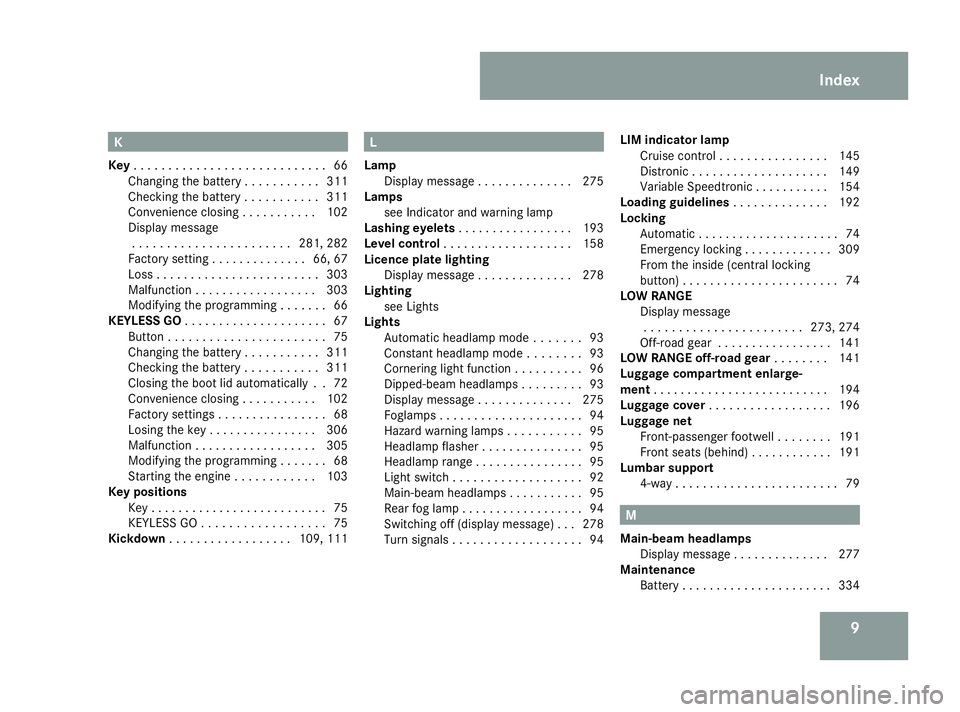
9K
Key . . . . . . . . . . . . . . . . . . . . . . . . . . . .66
Changing the battery . . . . . . . . . . .311
Checking the battery . . . . . . . . . . .311
Convenience closing . . . . . . . . . . .102
Display message . . . . . . . . . . . . . . . . . . . . . . .281, 282
Factory setting . . . . . . . . . . . . . .66, 67
Loss . . . . . . . . . . . . . . . . . . . . . . . .303
Malfunction . . . . . . . . . . . . . . . . . .303
Modifying the programming . . . . . . .66
KEYLESS GO . . . . . . . . . . . . . . . . . . . . .67
Button . . . . . . . . . . . . . . . . . . . . . . .75
Changing the battery . . . . . . . . . . .311
Checking the battery . . . . . . . . . . .311
Closing the boot lid automatically . .72
Convenience closin g.. . . . . . . . ..102
Factory settings . . . . . . . . . . . . . . . .68
Losing the key . . . . . . . . . . . . . . . .306
Malfunction . . . . . . . . . . . . . . . . . .305
Modifying the programming . . . . . . .68
Starting the engine . . . . . . . . . . . .103
Key positions
Key . . . . . . . . . . . . . . . . . . . . . . . . . .75
KEYLESS GO . . . . . . . . . . . . . . . . . .75
Kickdown . . . . . . . . . . . . . . . . . .109, 111 L
Lamp Display message . . . . . . . . . . . . . .275
Lamps
see Indicator and warning lamp
Lashing eyelets . . . . . . . . . . . . . . . . .193
Level control . . . . . . . . . . . . . . . . . . .158
Licence plate lighting Display message . . . . . . . . . . . . . .278
Lighting
see Lights
Lights
Automatic headlamp mode . . . . . . .93
Constant headlamp mod e.. . . . . ..93
Cornering light function . . . . . . . . . .96
Dipped-beam headlamps . . . . . . . . .93
Display message . . . . . . . . . . . . . .275
Foglamps . . . . . . . . . . . . . . . . . . . . .94
Hazard warning lamps . . . . . . . . . . .95
Headlamp flasher . . . . . . . . . . . . . . .95
Headlamp range . . . . . . . . . . . . . . . .95
Light switch . . . . . . . . . . . . . . . . . . .92
Main-beam headlamps . . . . . . . . . . .95
Rear fog lamp . . . . . . . . . . . . . . . . . .94
Switching off (display message) . . .278
Turn signals . . . . . . . . . . . . . . . . . . .94LIM indicator lamp
Cruise control . . . . . . . . . . . . . . . .145
Distronic . . . . . . . . . . . . . . . . . . . .149
Variable Speedtronic . . . . . . . . . . .154
Loading guidelines . . . . . . . . . . . . ..192
Locking Automatic . . . . . . . . . . . . . . . . . . . . .74
Emergency locking . . . . . . . . . . . . .309
From the inside (central locking
button) . . . . . . . . . . . . . . . . . . . . . . .74
LOW RANGE
Display message. . . . . . . . . . . . . . . . . . . . . . .273, 274
Off-road gear . . . . . . . . . . . . . . . . .141
LOW RANGE off-road gear . . . . . . ..141
Luggage compartment enlarge-
ment . . . . . . . . . . . . . . . . . . . . . . . . . .194
Luggage cover . . . . . . . . . . . . . . . . . .196
Luggage net Front-passenger footwell . . . . . . . .191
Front seats (behind) . . . . . . . . . . . .191
Lumbar support
4-way . . . . . . . . . . . . . . . . . . . . . . . .79 M
Main-beam headlamps Display message . . . . . . . . . . . . . .277
Maintenance
Battery . . . . . . . . . . . . . . . . . . . . . .334 Index
164_AKB; 5; 5, en-GB
wobuchh,
Version: 2.10.6 2008-05-11T11:55:12+02:00 - Seite 9Dateiname: 6515_4293_02_buchblock.pdf; preflight
Page 40 of 381
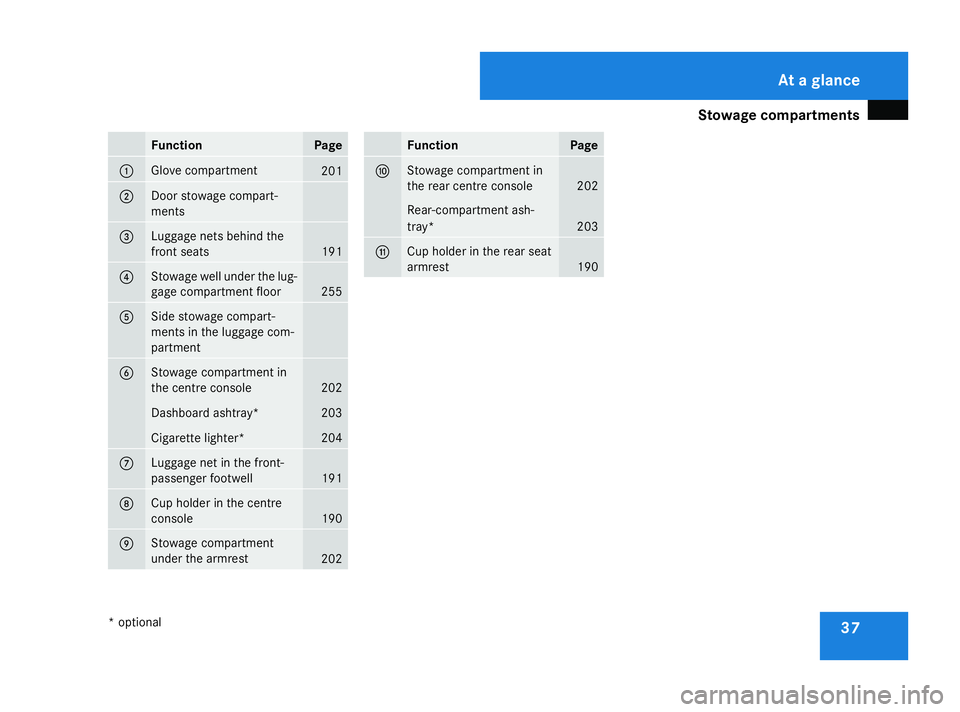
Stowage compartments
37Function Page
1 Glove compartment
201
2 Door stowage compart-
ments
3 Luggage nets behind the
front seats
191
4 Stowage well under the lug-
gage compartment floor
255
5 Side stowage compart-
ments in the luggage com-
partment
6 Stowage compartment in
the centre console
202
Dashboard ashtray* 203
Cigarette lighter* 204
7 Luggage net in the front-
passenger footwell
191
8 Cup holder in the centre
console
190
9 Stowage compartment
under the armrest
202 Function Page
a Stowage compartment in
the rear centre console
202
Rear-compartment ash-
tray*
203
b Cup holder in the rear seat
armrest
190 At a glance
* optional
164_AKB; 5; 5, en-GB
wobuchh,
Version: 2.10.6 2008-05-11T11:55:12+02:00 - Seite 37Dateiname: 6515_4293_02_buchblock.pdf; preflight
Page 46 of 381
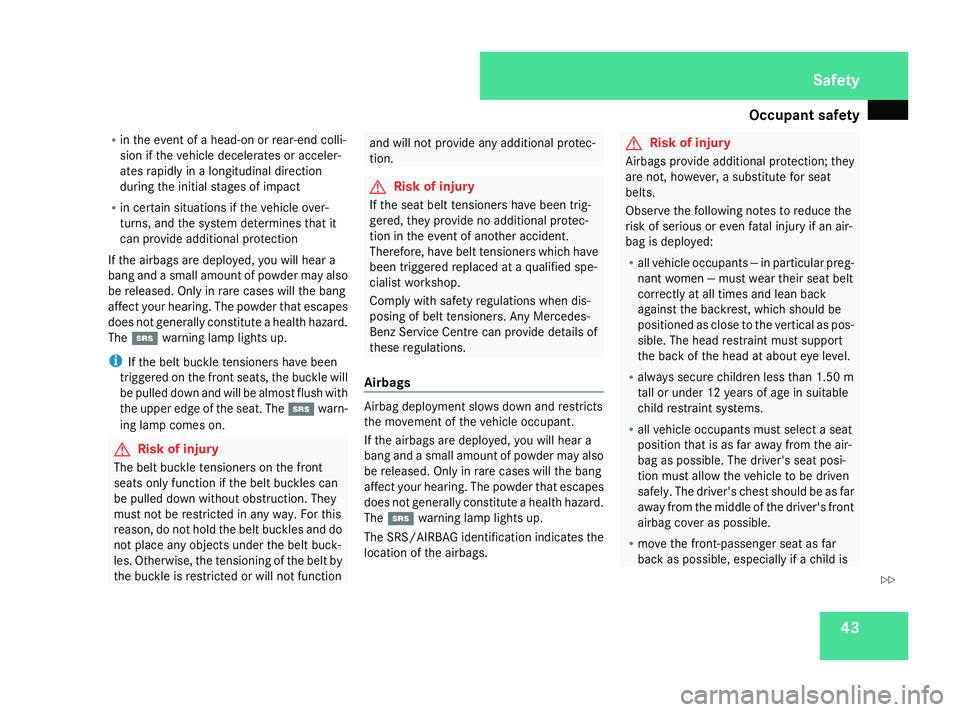
Occupant safety
43
R
in the event of a head-on or rear-end colli-
sion if the vehicle decelerates or acceler-
ates rapidly in a longitudinal direction
during the initial stages of impact
R in certain situations if the vehicle over-
turns, and the system determines that it
can provide additional protection
If the airbags are deployed, you will hear a
bang and a small amount of powder may also
be released. Only in rare cases will the bang
affect your hearing. The powder that escapes
does not generally constitute a health hazard.
The 1 warning lamp lights up.
i If the belt buckle tensioners have been
triggered on the front seats, the buckle will
be pulled down and will be almost flush with
the upper edge of the seat. The 1warn-
ing lamp comes on. G
Risk of injury
The belt buckle tensioners on the front
seats only function if the belt buckles can
be pulled down without obstruction. They
must not be restricted in any way. For this
reason, do not hold the belt buckles and do
not place any objects under the belt buck-
les. Otherwise, the tensioning of the belt by
the buckle is restricted or will not function and will not provide any additional protec-
tion. G
Risk of injury
If the seat belt tensioners have been trig-
gered, they provide no additional protec-
tion in the event of another accident.
Therefore, have belt tensioners which have
been triggered replaced at a qualified spe-
cialist workshop.
Comply with safety regulations when dis-
posing of belt tensioners. Any Mercedes-
Benz Service Centre can provide details of
these regulations.
Airbags Airbag deployment slows down and restricts
the movement of the vehicle occupant.
If the airbags are deployed, you will hear a
bang and a small amount of powder may also
be released. Only in rare cases will the bang
affect your hearing. The powder that escapes
does not generally constitute a health hazard.
The 1 warning lamp lights up.
The SRS/AIRBAG identification indicates the
location of the airbags. G
Risk of injury
Airbags provide additional protection; they
are not, however, a substitute for seat
belts.
Observe the following notes to reduce the
risk of serious or even fatal injury if an air-
bag is deployed:
R all vehicle occupants — in particular preg-
nant women — must wear their seat belt
correctly at all times and lean back
against the backrest, which should be
positioned as close to the vertical as pos-
sible. The head restraint must support
the back of the head at about eye level.
R always secure children less than 1.50 m
tall or under 12 years of age in suitable
child restraint systems.
R all vehicle occupants must select a seat
position that is as far away from the air-
bag as possible. The driver's seat posi-
tion must allow the vehicle to be driven
safely. The driver's chest should be as far
away from the middle of the driver's front
airbag cover as possible.
R move the front-passenger seat as far
back as possible, especially if a child is Safety
164_AKB; 5; 5, en-GB
wobuchh,
Version: 2.10.6 2008-05-11T11:55:12+02:00 - Seite 43 ZDateiname: 6515_4293_02_buchblock.pdf; preflight
Page 47 of 381
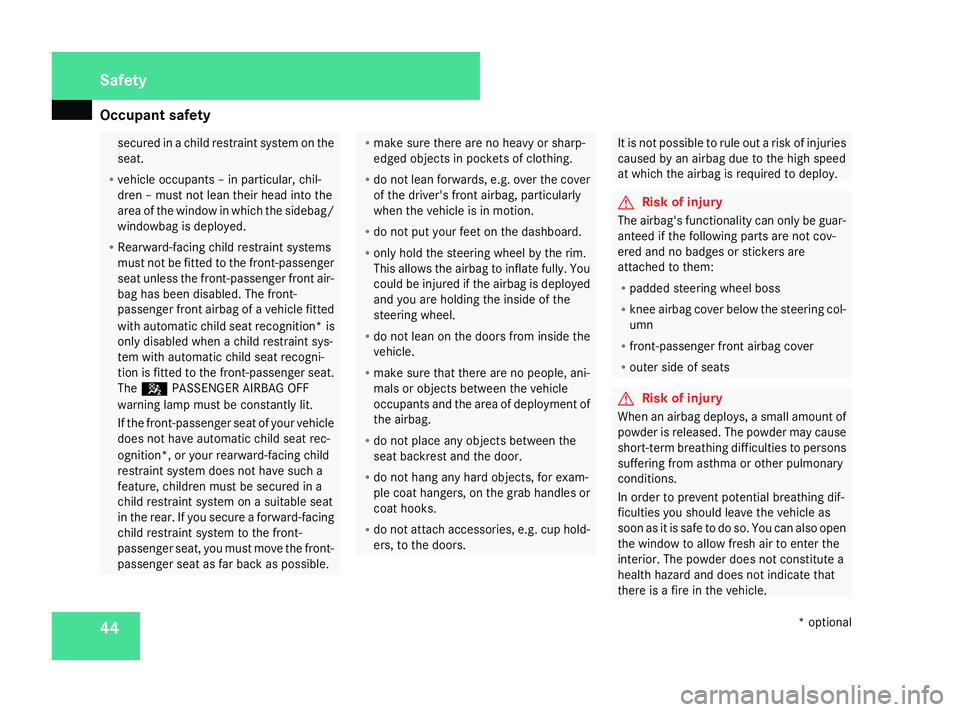
Occupant safety
44 secured in a child restraint system on the
seat.
R vehicle occupants – in particular, chil-
dren – must not lean their head into the
area of the window in which the sidebag/
windowbag is deployed.
R Rearward-facing child restraint systems
must not be fitted to the front-passenger
seat unless the front-passenger front air-
bag has been disabled. The front-
passenger front airbag of a vehicle fitted
with automatic child seat recognition* is
only disabled when a child restraint sys-
tem with automatic child seat recogni-
tion is fitted to the front-passenger seat.
The 5 PASSENGER AIRBAG OFF
warning lamp must be constantly lit.
If the front-passenger seat of your vehicle
does not have automatic child seat rec-
ognition*, or your rearward-facing child
restraint system does not have such a
feature, children must be secured in a
child restraint system on a suitable seat
in the rear. If you secure a forward-facing
child restraint system to the front-
passenger seat, you must move the front-
passenger seat as far back as possible. R
make sure there are no heavy or sharp-
edged objects in pockets of clothing.
R do not lean forwards, e.g. over the cover
of the driver's front airbag, particularly
when the vehicle is in motion.
R do not put your feet on the dashboard.
R only hold the steering wheel by the rim.
This allows the airbag to inflate fully. You
could be injured if the airbag is deployed
and you are holding the inside of the
steering wheel.
R do not lean on the doors from inside the
vehicle.
R make sure that there are no people, ani-
mals or objects between the vehicle
occupants and the area of deployment of
the airbag.
R do not place any objects between the
seat backrest and the door.
R do not hang any hard objects, for exam-
ple coat hangers, on the grab handles or
coat hooks.
R do not attach accessories, e.g. cup hold-
ers, to the doors. It is not possible to rule out a risk of injuries
caused by an airbag due to the high speed
at which the airbag is required to deploy.
G
Risk of injury
The airbag's functionality can only be guar-
anteed if the following parts are not cov-
ered and no badges or stickers are
attached to them:
R padded steering wheel boss
R knee airbag cover below the steering col-
umn
R front-passenger front airbag cover
R outer side of seats G
Risk of injury
When an airbag deploys, a small amount of
powder is released. The powder may cause
short-term breathing difficulties to persons
suffering from asthma or other pulmonary
conditions.
In order to prevent potential breathing dif-
ficulties you should leave the vehicle as
soon as it is safe to do so. You can also open
the window to allow fresh air to enter the
interior. The powder does not constitute a
health hazard and does not indicate that
there is a fire in the vehicle. Safety
* optional
164_AKB; 5; 5, en-GB
wobuchh,
Version: 2.10.6 2008-05-11T11:55:12+02:00 - Seite 44Dateiname: 6515_4293_02_buchblock.pdf; preflight
Page 50 of 381

Occupant safety
47
R
independently of the front airbags
R regardless of whether the front-passenger
seat is occupied PRE-SAFE
®
system
PRE-SAFE ®
system takes pre-emptive meas-
ures to protect you in certain hazardous sit-
uations.
PRE-SAFE ®
intervenes in the event of:
R emergency braking situations, e.g. if BAS
Brake Assist intervenes
R critical situations involving driving dynam-
ics, e.g. if the vehicle oversteers or under-
steers significantly due to physical limits
being exceeded
If you are driving faster than approximately
35 km/h, PRE-SAFE ®
takes the following
measures in the aforementioned situations:
R It tensions the front seat belts.
R Vehicle with memory functions*: it adjusts
the front-passenger seat if this is in an
unfavourable position.
R If the vehicle skids, it closes the sliding/
tilting sunroof* and side windows so that
only a small gap remains. If the hazardous situation passes without
resulting in an accident, PRE-SAFE
®
releases
the belt pretensioning. You can then reverse
all settings made by PRE-SAFE ®
again.
If the seat belts are not released:
X Move the backrest or the seat back slightly
until the belt tension is reduced.
The locking mechanism releases. G
Risk of injury
Make sure when adjusting the seat that
nobody can become trapped.
! Make sure that there are no objects in the
footwell or behind the seats when adjusting
the seats. You could otherwise damage the
seats and the objects. NECK-PRO head restraint
NECK-PRO head restraints are designed to
increase protection to the driver's and front-
passenger's head and neck. To this end, the
head restraints on the driver's and front-
passenger seats are moved forwards and
upwards in the event of a rear-end collision
when viewed in the direction of travel. This
provides better head support. G
Risk of injury
Head restraint covers prevent the NECK-
PRO head restraints from triggering cor-
rectly. Consequently, the NECK-PRO head
restraints cannot provide the intended level
of protection. Do not use head restraint
covers.
If the NECK-PRO head restraints are triggered
in an accident, you must reset the head
restraints on the driver's and front-passenger
seats (Y page 310). Head restraints that have
been triggered are tilted forwards. Safety
* optional
164_AKB; 5; 5, en-GB
wobuchh,
Version: 2.10.6 2008-05-11T11:55:12+02:00 - Seite 47 ZDateiname: 6515_4293_02_buchblock.pdf; preflight
Page 52 of 381
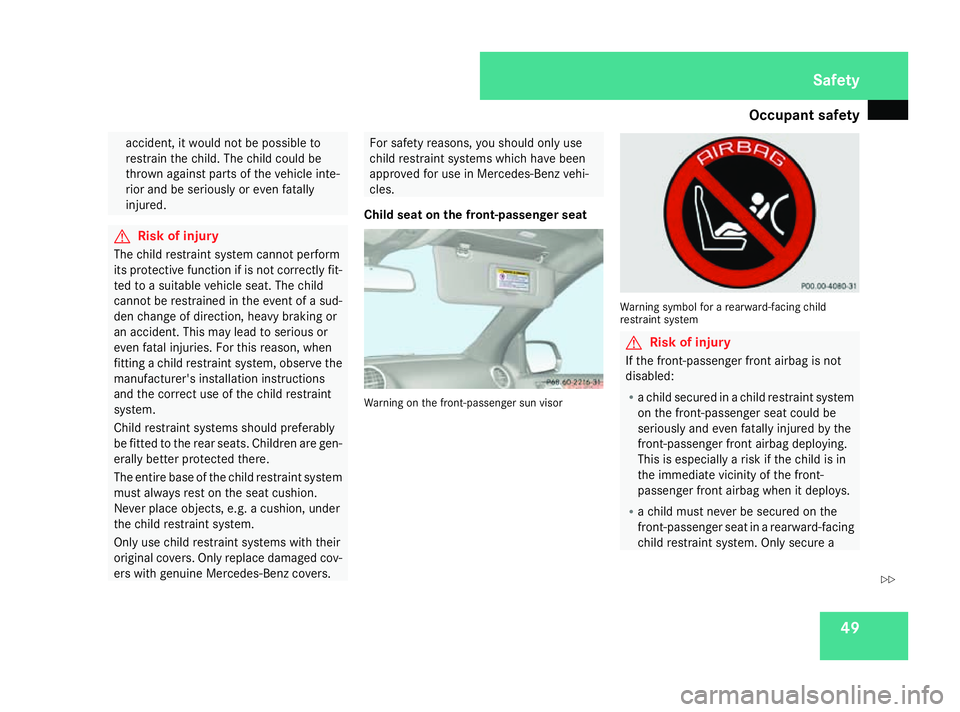
Occupant safety
49accident, it would not be possible to
restrain the child. The child could be
thrown against parts of the vehicle inte-
rior and be seriously or even fatally
injured. G
Risk of injury
The child restraint system cannot perform
its protective function if is not correctly fit-
ted to a suitable vehicle seat. The child
cannot be restrained in the event of a sud-
den change of direction, heavy braking or
an accident. This may lead to serious or
even fatal injuries. For this reason, when
fitting a child restraint system, observe the
manufacturer's installation instructions
and the correct use of the child restraint
system.
Child restraint systems should preferably
be fitted to the rear seats. Children are gen-
erally better protected there.
The entire base of the child restraint system
must always rest on the seat cushion.
Never place objects, e.g. a cushion, under
the child restraint system.
Only use child restraint systems with their
original covers. Only replace damaged cov-
ers with genuine Mercedes-Benz covers. For safety reasons, you should only use
child restraint systems which have been
approved for use in Mercedes-Benz vehi-
cles.
Child seat on the front-passenger seat Warning on the front-passenger sun visor Warning symbol for a rearward-facing child
restraint system
G
Risk of injury
If the front-passenger front airbag is not
disabled:
R a child secured in a child restraint system
on the front-passenger seat could be
seriously and even fatally injured by the
front-passenger front airbag deploying.
This is especially a risk if the child is in
the immediate vicinity of the front-
passenger front airbag when it deploys.
R a child must never be secured on the
front-passenger seat in a rearward-facing
child restraint system. Only secure a Safety
164_AKB; 5; 5, en-GB
wobuchh, Version: 2.10.6 2008-05-11T11:55:12+02:00 - Seite 49 ZDateiname: 6515_4293_02_buchblock.pdf; preflight
Page 54 of 381
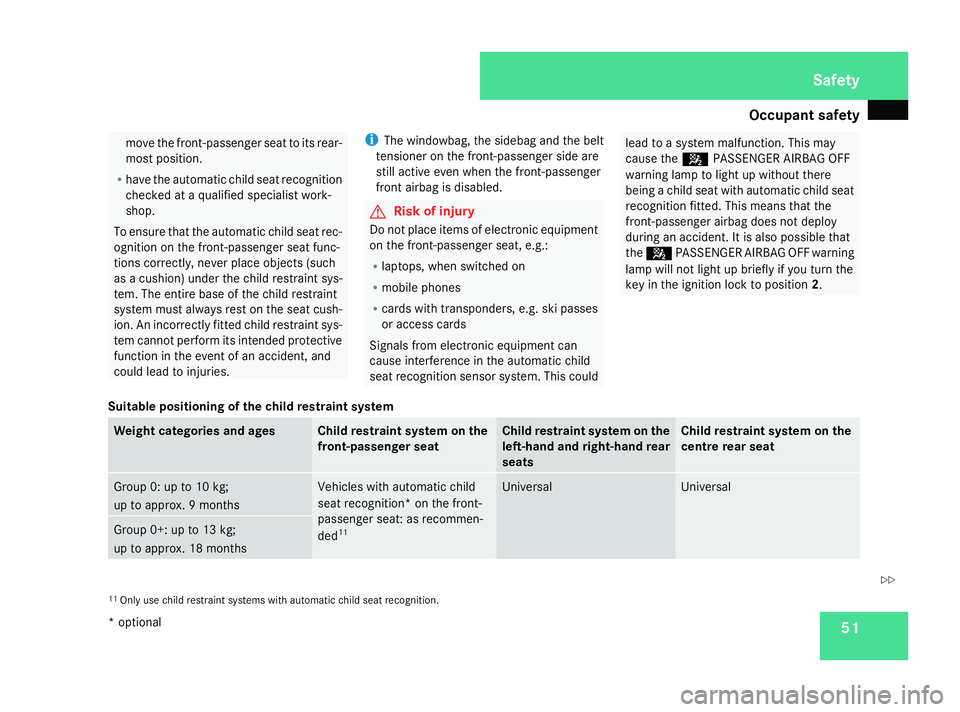
Occupant safety
51move the front-passenger seat to its rear-
most position.
R have the automatic child seat recognition
checked at a qualified specialist work-
shop.
To ensure that the automatic child seat rec-
ognition on the front-passenger seat func-
tions correctly, never place objects (such
as a cushion) under the child restraint sys-
tem. The entire base of the child restraint
system must always rest on the seat cush-
ion. An incorrectly fitted child restraint sys-
tem cannot perform its intended protective
function in the event of an accident, and
could lead to injuries. i
The windowbag, the sidebag and the belt
tensioner on the front-passenger side are
still active even when the front-passenger
front airbag is disabled. G
Risk of injury
Do not place items of electronic equipment
on the front-passenger seat, e.g.:
R laptops, when switched on
R mobile phones
R cards with transponders, e.g. ski passes
or access cards
Signals from electronic equipment can
cause interference in the automatic child
seat recognition sensor system. This could lead to a system malfunction. This may
cause the
5PASSENGER AIRBAG OFF
warning lamp to light up without there
being a child seat with automatic child seat
recognition fitted. This means that the
front-passenger airbag does not deploy
during an accident. It is also possible that
the 5 PASSENGER AIRBAG OFF warning
lamp will not light up briefly if you turn the
key in the ignition lock to position 2.
Suitable positioning of the child restraint system Weight categories and ages Child restraint system on the
front-passenger seat Child restraint system on the
left-hand and right-hand rear
seats Child restraint system on the
centre rear seat
Group 0: up to 10 kg;
up to approx. 9 months Vehicles with automatic child
seat recognition* on the front-
passenger seat: as recommen-
ded
11 Universal Universal
Group 0+: up to 13 kg;
up to approx. 18 months 11
Only use child restraint systems with automatic child seat recognition. Safety
* optional
164_AKB; 5; 5, en-GB
wobuchh,
Version: 2.10.6 2008-05-11T11:55:12+02:00 - Seite 51 ZDateiname: 6515_4293_02_buchblock.pdf; preflight
Page 55 of 381
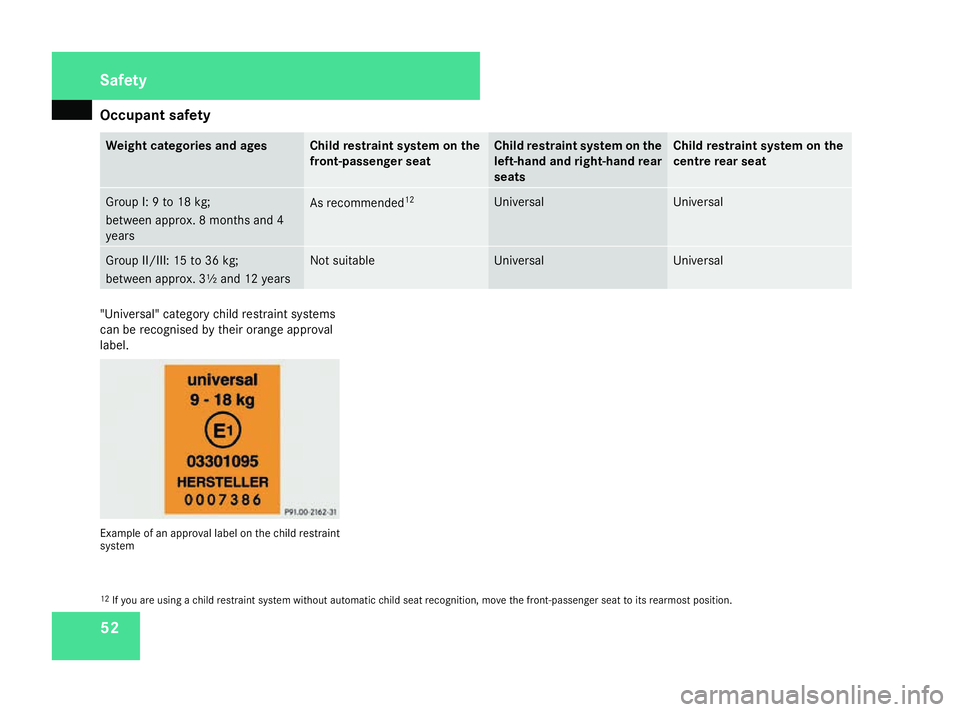
Occupant safety
52 Weight categories and ages Child restraint system on the
front-passenger seat Child restraint system on the
left-hand and right-hand rear
seats Child restraint system on the
centre rear seat
Group I: 9 to 18 kg;
between approx. 8 months and 4
years As recommended
12 Universal Universal
Group II/III: 15 to 36 kg;
between approx. 3½ and 12 years Not suitable Universal Universal
"Universal" category child restraint systems
can be recognised by their orange approval
label. Example of an approval label on the child restraint
system
12 If you are using a child restraint system without automatic child seat recognition, move the front-passenger seat to its rearmost position. Safety
164_AKB; 5; 5, en-GB
wobuchh,
Version: 2.10.6 2008-05-11T11:55:12+02:00 - Seite 52Dateiname: 6515_4293_02_buchblock.pdf; preflight
Page 56 of 381
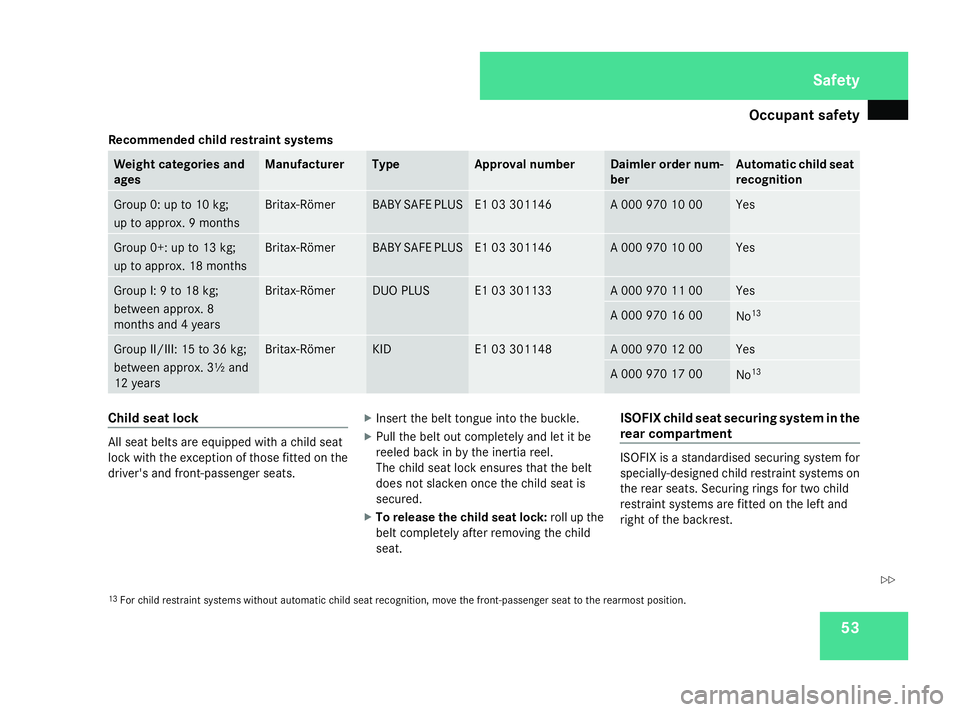
Occupant safety
53
Recommended child restraint systems Weight categories and
ages Manufacturer Type Approval number Daimler order num-
ber Automatic child seat
recognition
Group 0: up to 10 kg;
up to approx. 9 months Britax-Römer BABY SAFE PLUS E1 03 301146 A 000 970 10 00 Yes
Group 0+: up to 13 kg;
up to approx. 18 months Britax-Römer BABY SAFE PLUS E1 03 301146 A 000 970 10 00 Yes
Group I: 9 to 18 kg;
between approx. 8
months and 4 years Britax-Römer DUO PLUS E1 03 301133 A 000 970 11 00 Yes
A 000 970 16 00
No
13 Group II/III: 15 to 36 kg;
between approx. 3½ and
12 years Britax-Römer KID E1 03 301148 A 000 970 12 00 Yes
A 000 970 17 00
No
13 Child seat lock
All seat belts are equipped with a child seat
lock with the exception of those fitted on the
driver's and front-passenger seats. X
Insert the belt tongue into the buckle.
X Pull the belt out completely and let it be
reeled back in by the inertia reel.
The child seat lock ensures that the belt
does not slacken once the child seat is
secured.
X To release the child seat lock: roll up the
belt completely after removing the child
seat. ISOFIX child seat securing system in the
rear compartment ISOFIX is a standardised securing system for
specially-designed child restraint systems on
the rear seats. Securing rings for two child
restraint systems are fitted on the left and
right of the backrest.
13 For child restraint systems without automatic child seat recognition, move the front-passenger seat to the rearmost position. Safety
164_AKB; 5; 5, en-GB
wobuchh,
Version: 2.10.6 2008-05-11T11:55:12+02:00 - Seite 53 ZDateiname: 6515_4293_02_buchblock.pdf; preflight
Page 57 of 381
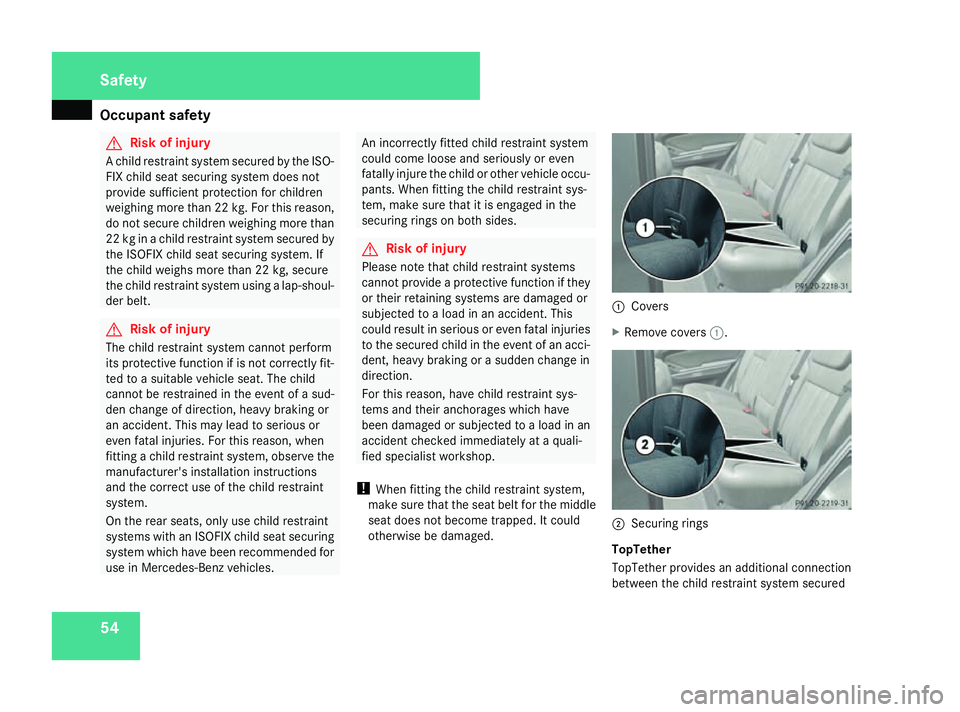
Occupant safety
54 G
Risk of injury
A child restraint system secured by the ISO-
FIX child seat securing system does not
provide sufficient protection for children
weighing more than 22 kg. For this reason,
do not secure children weighing more than
22 kg in a child restraint system secured by
the ISOFIX child seat securing system. If
the child weighs more than 22 kg, secure
the child restraint system using a lap-shoul-
der belt. G
Risk of injury
The child restraint system cannot perform
its protective function if is not correctly fit-
ted to a suitable vehicle seat. The child
cannot be restrained in the event of a sud-
den change of direction, heavy braking or
an accident. This may lead to serious or
even fatal injuries. For this reason, when
fitting a child restraint system, observe the
manufacturer's installation instructions
and the correct use of the child restraint
system.
On the rear seats, only use child restraint
systems with an ISOFIX child seat securing
system which have been recommended for
use in Mercedes-Benz vehicles. An incorrectly fitted child restraint system
could come loose and seriously or even
fatally injure the child or other vehicle occu-
pants. When fitting the child restraint sys-
tem, make sure that it is engaged in the
securing rings on both sides. G
Risk of injury
Please note that child restraint systems
cannot provide a protective function if they
or their retaining systems are damaged or
subjected to a load in an accident. This
could result in serious or even fatal injuries
to the secured child in the event of an acci-
dent, heavy braking or a sudden change in
direction.
For this reason, have child restraint sys-
tems and their anchorages which have
been damaged or subjected to a load in an
accident checked immediately at a quali-
fied specialist workshop.
! When fitting the child restraint system,
make sure that the seat belt for the middle
seat does not become trapped. It could
otherwise be damaged. 1
Covers
X Remove covers 1. 2
Securing rings
TopTether
TopTether provides an additional connection
between the child restraint system secured Safety
164_AKB; 5; 5, en-GB
wobuchh,
Version: 2.10.6 2008-05-11T11:55:12+02:00 - Seite 54Dateiname: 6515_4293_02_buchblock.pdf; preflight